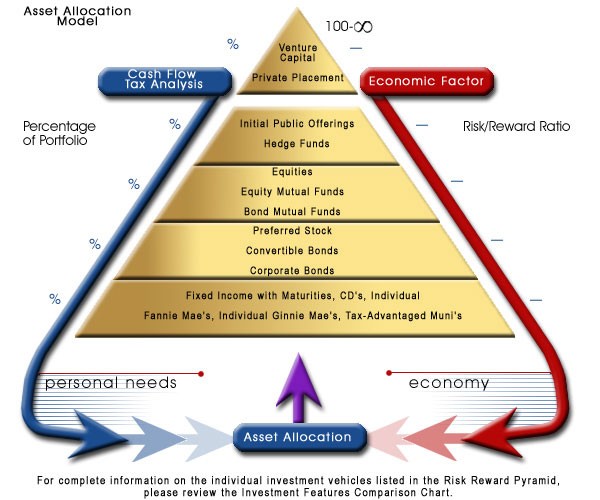Asset Allocation
Post on: 27 Июнь, 2015 No Comment

Home Asset Allocation -
Understanding Your True Asset Mix
Over the past 20 years, asset allocation has increasingly become the foundation of individual as well as institutional investment portfolios. Yet, while many people are familiar with the concept, not all fully understand what it means to them and their investments.
Asset allocation entails exchanging the potential to reap a higher return – and the risk of taking an equally dramatic loss – for the likelihood of generating a more consistent, positive return over the long term.
The general idea is that instead of devoting the bulk of your assets to a particular sector or even one specific investment, you choose different types of investments. Underlying this decision is the assumption that each asset class will react somewhat differently to a given event. For example, if interest rates rise, some asset classes should, as a whole, increase in value. Conversely, the value of some of your investments will tend to decline in the same environment – but should flourish when rates drop.
Basic Asset Classes
Depending on your appetite for risk, the economic environment, your specific investment objectives and other factors, your portfolio might include some or all of the following:
- Cash and cash equivalents
- U.S. equities
- Non-U.S. equities
- Fixed income
- Real estate
- Alternative investments
If you’re primarily interested in securing a regular income, your portfolio may be heavily weighted toward fixed income. If you’re more focused on long-term appreciation, some balance of equities and other growth-oriented investments may form the core of your portfolio.
Diving Deeper
While the overall concept of asset allocation is fairly straightforward, determining precisely how your assets are allocated is typically more complicated. That’s because most portfolios include some sort of packaged investment products that are themselves divided among asset categories.
For example, while some mutual funds may fundamentally represent a single asset class (e.g. stocks), many others combine several types of securities. In addition, mutual fund managers must also typically allocate some of their funds’ holdings to cash or cash equivalent investments to meet daily redemptions from shareholders and pay the expenses of operating and managing the funds.
To truly understand your overall portfolio allocation, you and your advisor must not only look at individual asset classes, but assess the components of the mutual funds you own. That involves breaking packaged investments down to their individual holdings, or “x-raying” and assessing each to see what’s inside, as shown in the graphic above.
Finding the Right Mix
By looking deeper into the actual holdings within a mutual fund or other packaged investment, you and your advisor may determine that your overall allocation should be adjusted. For instance, a balanced fund may hold both fixed income and equities, with the equity portion including both domestic and international securities.
If you already have direct investments in companies operating in a country that is represented within the fund, you might consider adjusting your holdings to lessen your overall exposure to that particular country.
Your advisor can help you understand your portfolio’s true allocation by examining all of your assets and the vehicles in which they are held. Combining that knowledge with an understanding of your investment objectives and risk tolerance, he or she can then make recommendations to ensure your portfolio stays in line with your investing goals.
While prudent asset allocation of portfolio holdings cannot fully protect investors, economic conditions historically tend to affect dissimilar markets in different ways. And as a consequence, understanding asset allocation – and ensuring an appropriate mix of assets within your personal portfolio – is a solid strategy for balancing the risks of investing with the potential rewards.
Investors should carefully consider the investment objectives, risks, charges and expenses of mutual funds before investing. The prospectus contains this and other information about mutual funds. The prospectus is available from your financial advisor and should be read carefully before investing.
Asset allocation does not ensure a profit or protect against a loss. Investing involves risk and investors may incur a profit or a loss. There is an inverse relationship between interest rate movements and fixed income prices. Generally, when interest rates rise, fixed income prices fall and when interest rates fall, fixed income prices rise. International investing involves special risks, including currency fluctuations, different financial accounting standards, and possible political and economic volatility. Declines in the value of real estate, economic conditions, property taxes, tax laws and interest rates all present potential risks to real estate investments. Alternative investments involve specific risks that may be greater than those associated with traditional investments and may be offered only to clients who meet specific suitability requirements, including minimum-net-worth tests.
This information is not a complete summary or statement of all available data necessary for making an investment decision. Investing involves risk and investors may incur a profit or a loss. You should discuss any tax matters with the appropriate professional.
Feel free to take our free Financial Quiz found here.
CFP | Certified Financial Planner | Certified Financial Planner | Certified Financial Planner Board of Standards, Inc. owns the certification marks above, which it awards to individuals who successfully complete initial and ongoing certification requirements. Securities offered through Raymond James Financial Services, Inc. member FINRA / SIPC














